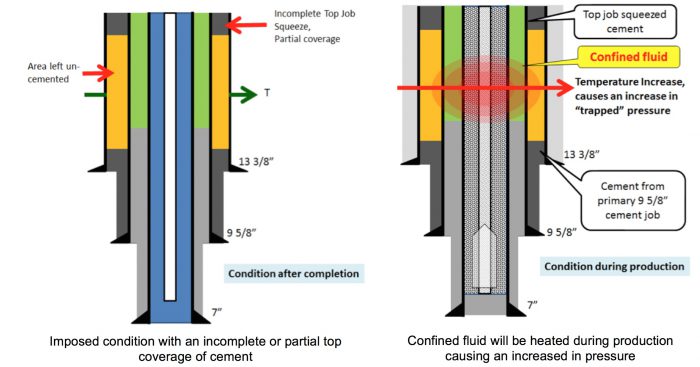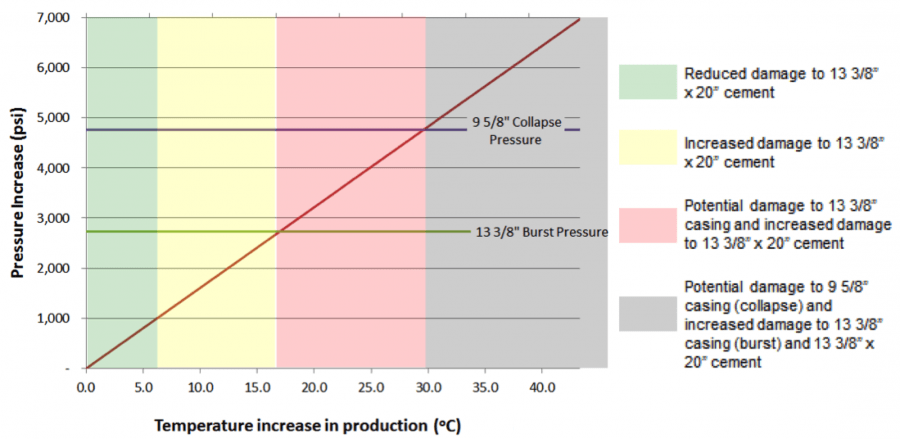Primary cementing objective recap
Trapped pressure is always something to be aware of in cementing. A common objective of the primary cementing operation of intermediate casings is to have the top of the cement at the surface. In some cases, due to the presence of losses during or after the cement placement, this objective is not achieved. This means that the annular space between intermediate and surface casings is left uncovered.
 Top job squeeze
Top job squeeze
In the past, I have seen some companies attempting to inject cement through the side valves. This is sometimes to have a ring of cement close to the surface. Or, to repair the previous casing shoe following losses during primary cementing.
This procedure can be called a ‘Top Job Squeeze’ because it implies squeezing fluid below the previous casing shoe while pumping cement from the top. However, there is a challenge due to the typically large volume of the casing x casing annular space and uncertainty of the injection behavior. (Leaking formation might get plugged). The cement slurry pumped from the top might partially fill the available volume before reaching the maximum allowable squeeze pressure.
Trapped pressure leading to a trapped annulus
When the intermediate casing is part of the completion (in case of a production liner), the situation described above creates the conditions for a ‘trapped annulus’. This is the result of a confined liquid (typically water and/or mud) between the two casings being exposed to a temperature increase during production. The result is an increase in thermal expansion and an incidence of trapped pressure. This pressure increase under certain circumstances can result in damage to casings and outer cement.
See an example case below, with an assumed 9 5/8” intermediate casing. (Partially covered with cement). This is followed by a 7” production casing (With a designed TOC well-below surface).

The relationship between the thermal expansion and pressure increased for this hypothetical case is presented in the following graph.

The chart shows that an increase in temperature of only about 16 C already puts in risk the integrity of the surface casing and its outer cement. Later a further increase up to 30 C can result in the collapse of the intermediate casing with severe damage to the production pipe.
This post only defines the problem of trapped pressure from incomplete cementing in general terms. Please if you have any comments, questions or require more clarifications let me know in the space below.
Cheers
L. Diaz


 Top job squeeze
Top job squeeze
A very large % of wells, especially in the GOM have leaking annuli do to poor or improper primary cementing practices. The % in the GOM is probably higher than land based wells due to the higher level of inspection , reporting and scrutiny from regulators. The fact is, too many wells have leaking annuli that at the least will cause premature structural failure and at the worst, endanger the welfare people living or working nearby. These leaks are extremely difficult to remediate due to casing geometries and restricted ability to pump into the leak, especially with a viscous fluid like cement.
Proper care in primary cementing is the solution and prevention has to be the objective. Proper attention to primary cementing best practices can yield tremendous results. The problem is that these best practices are not the cheapest. They are usually the most economical in light of expensive remediation, but they are not the cheapest until a problem arises.
James, you might contact Fred Sabins at CSI technologies. He has done a lot of work addressing this problem.
Thanks james cottom for your comment, This downturn presents a very nice opportunity. I believe Oil companies has the chance to learn were the profits are going away, now that they are very little to none, and be more efficient in the future. It should not be just a matter of going as fast and as cheap as possible with tough people taking war-type decision during well drilling and construction; what would happen with the well later should also count. In the near future, smarter and more well integrity-conscious drilling teams has to be put together using the best people around.
Follow the conversation in Linkedin